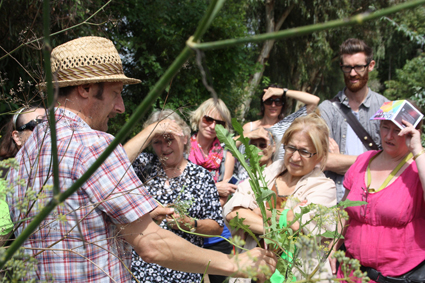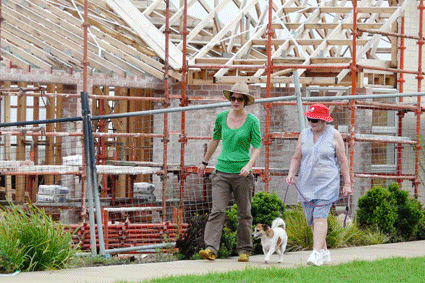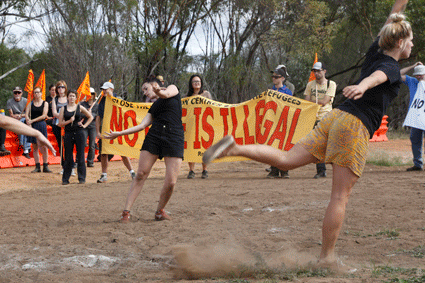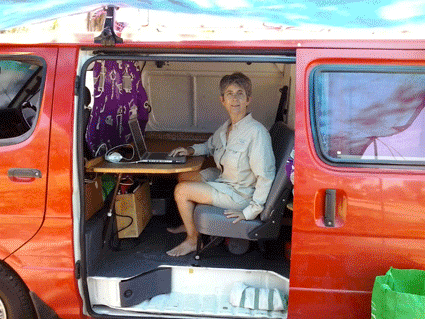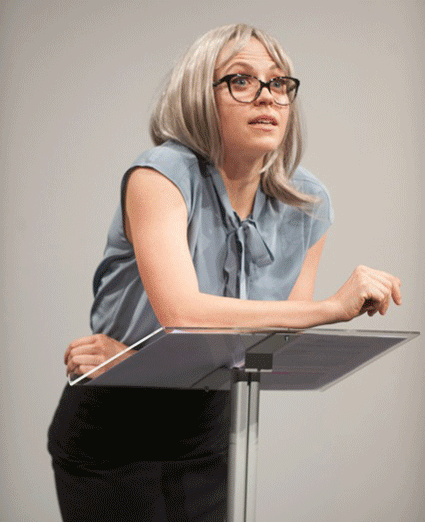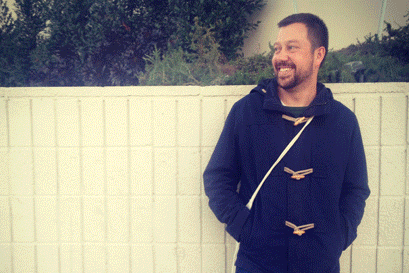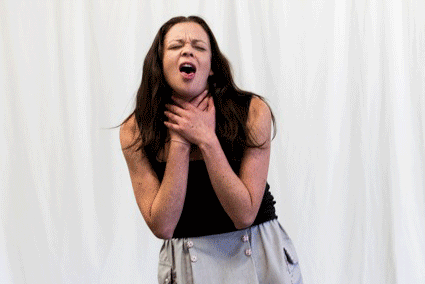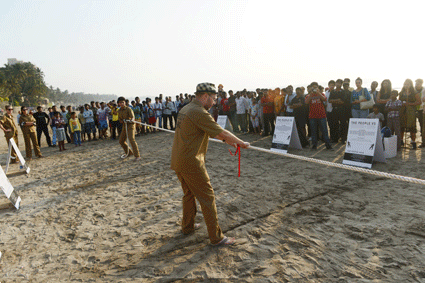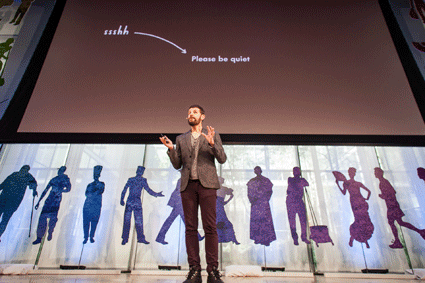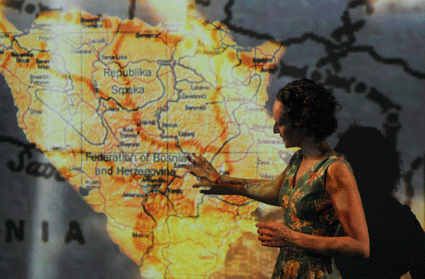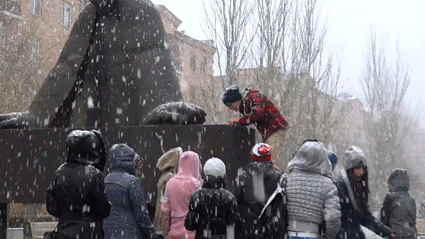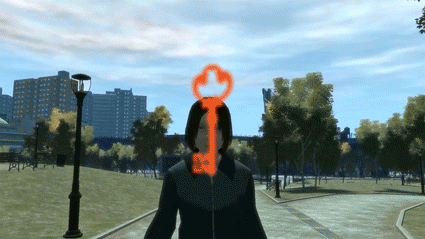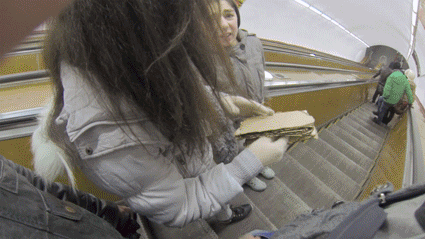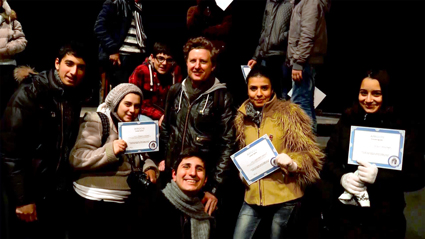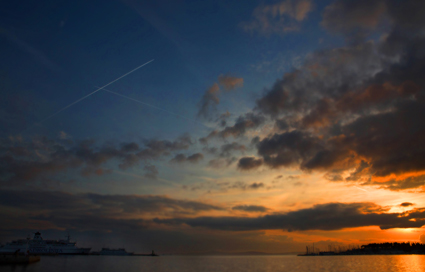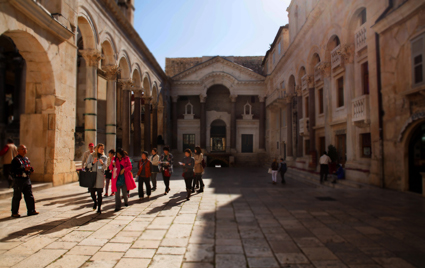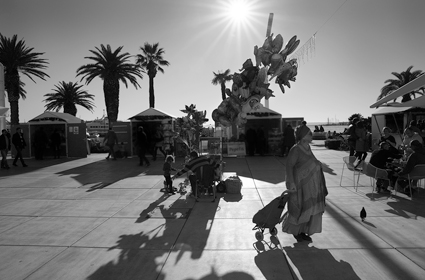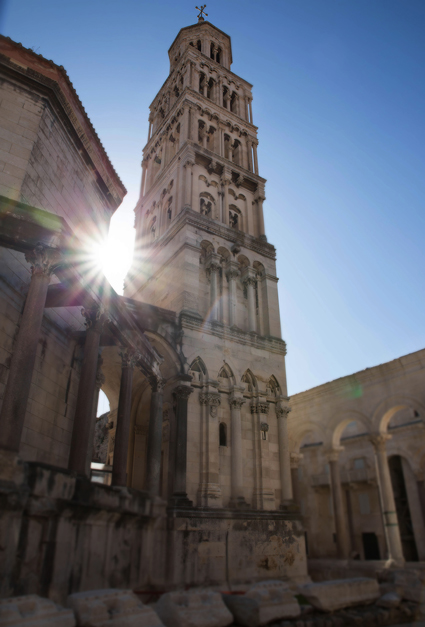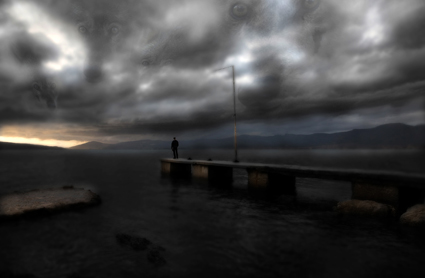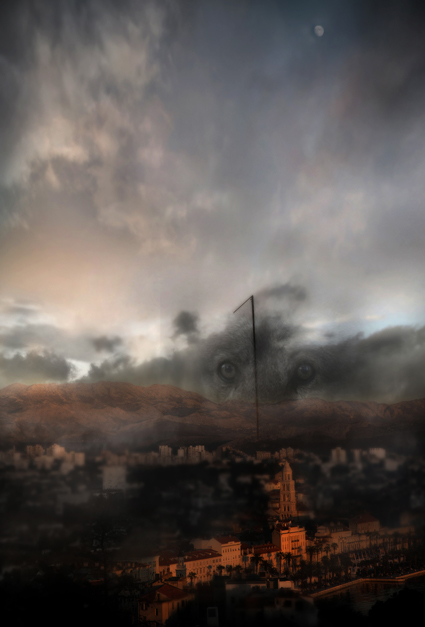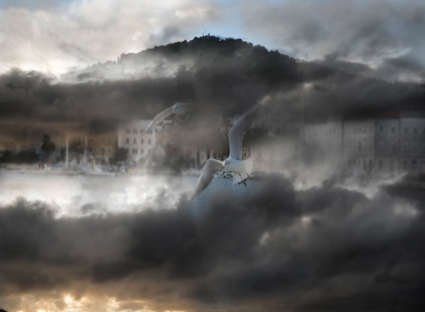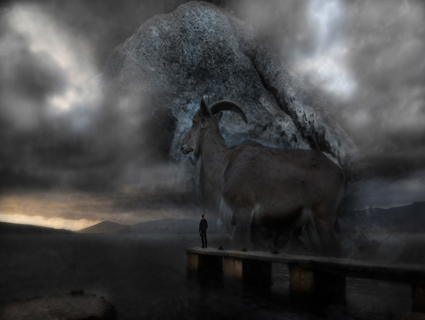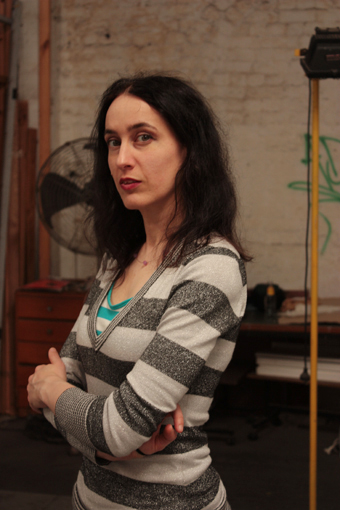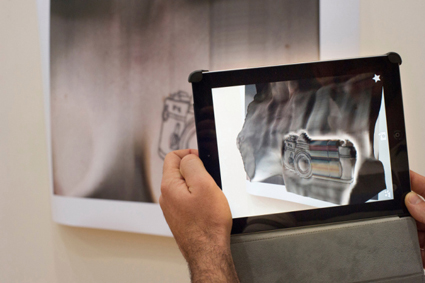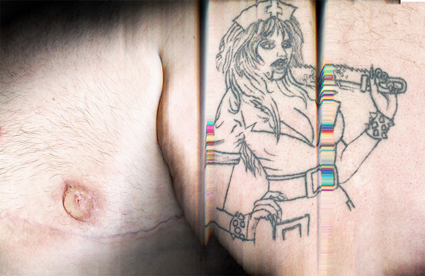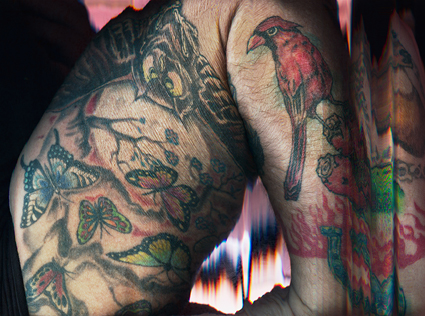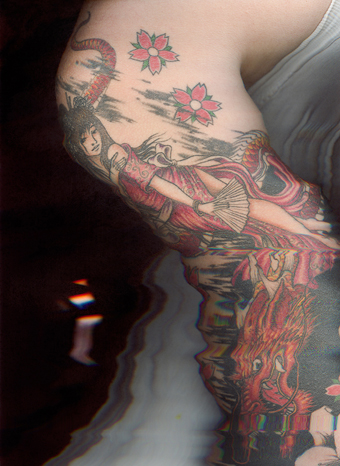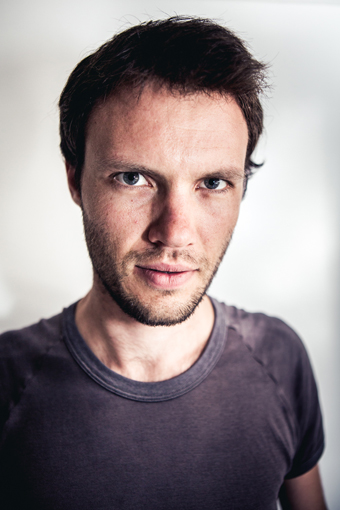March 2014
These are troubling times. Every day there seems to be another insidious attack on the principles and infrastructures that sustain democracy, and the decency and the responsibility to treat all humans equally. That’s a broad brushstroke statement, but the attacks are broad ranging, threatening Indigenous rights, asylum seekers’ rights, climate action, marriage equality, corporate accountability, education reform, independent media and most recently in Victoria the right to protest. In matters specifically related to the arts (though of course all are), there’s been the backlash against the Biennale Boycott artists and the threat to arms-length arts funding.
With this boiling away in our brains, we question the importance of what we do as artists. Do our creative deeds have an impact on social and political views? How do artists’ acts of defiance, revelation or subversion reach a wide enough audience to actually make a difference?
We’ve asked ten artists how they see their practice contributing to the debate about the power of art. While these questions have been asked before, in the current political climate it seems vitally important to pose them again.
We thank the artists who have very generously taken the time to share their thoughts with us.
Gail Priest, Online Producer
Diego Bonetto | Rosie Dennis | Sam Fox | Suzon Fuks | Nicola Gunn | Finegan Kruckemeyer | post | pvi collective | Jason Sweeney | Kym Vercoe
Diego Bonetto, Wild Food Tour
photo courtesy Casula Powerhouse
Diego Bonetto, Wild Food Tour
Diego Bonetto, artist
I believe cultural workers can do a lot in order to foster change. Art does have political agency as much any other human action.
Firstly, to art’s advantage there is a granted forum and that alone is a conduit to political relevance. Yes, that might come across as limiting and incestuous—preaching to converted—but that is only a limitation that individual practitioners want to place on themselves. I am a cultural worker and practice an artform that engages within the exhibition circuit of galleries and venues, but also exists outside of it, with activities that aspire to reach audiences way beyond, offering a message that is relevant to both.
Secondly I believe that by moving away from the modernist concept of a single artist’s output, we can effectively enable people to share in a vision and indeed be part of it, with invested interest. I collaborate with dancers and filmmakers, poets and fellow visual artists, but also extensively with non-art practitioners like chefs, herbalists, weavers, academics, programmers and media producers. The resulting projects have a much greater reach in language and cultural leverage—effectively becoming agents for political and social change.
Last, I’d like to praise the courage of artists, who adventure into structures not open to them, with creativity and conviction. That is when art is most effective politically. By fearlessly empowering themselves through distribution channels, media possibilities and platforms of cultural exchange, their political messages can then travel far and loud, reaching their targets and garnering attention without being mediated and ‘framed’ for public consumption: raw, clear, uncomfortable, honest, effective.
To that effect, in my projects I am not shamed to self-promote, engaging directly with journalists and scientists, policy-makers and managers of institutions, government bodies and Not For Profits. I believe that art does indeed have agency. It is only up to the individual to define what it is that they want to do with it.
www.weedyconnection.com: an environmental campaign
http://wildfood.in: a free resource for the location of wild food and medicine
www.bigfagpress.org: an artist-run printing facility
http://www.greenbans.net.au/: a celebration of 40 years of social activism in Sydney
https://www.youtube.com/watch?v=vVrbiYDpYIs: Redfern-Waterloo Tour of Beauty
Related articles
A garden experiment
Alana Hunt: tending, Sydney College of the Arts
RealTime issue #103 June-July 2011 p4
Finding a place in the art world
Lucas Ihlein: John Demos at Big Fag Press
RealTime issue #118 Dec-Jan 2013 p6
Rosie Dennis 1) Driven to New Pastures, photo Marilyn Moreno 2) Downtown, photo Heidrun Löhr 3) Bankstown Bayanian Hopping Spirit House by Alwin Reamillo, photo Jagath Dheerasekara
Rosie Dennis, Urban Theatre Projects
It’s almost five years since I met 79-year-old June Hickey, a resident in the southwest Sydney suburb of Minto. Our paths crossed when I was making the show Driven To New Pastures, a work I was inspired to write when a colleague said they weren’t that comfortable visiting me at my home in Waterloo because of all the public housing on my street. I was taken aback by their comment, which I perceived to be a broad generalisation about the people who were my neighbours. Those two words—public housing—reduced families, cultures, lives and individual experiences into a narrow, stereotyped portrait of the people who live in social housing.
After a about four or five months of knowing June, I asked her if she wanted to join me on stage in Driven To New Pastures. She agreed and we premiered the show at a small church hall in Minto before taking it to the Seymour Centre for Sydney Festival.
Since Driven to New Pastures I have worked on a number of projects which have required me to work closely with people from outside the arts industry and with little or no experience of contemporary performance practice – MINTO:LIVE, Downtown, Life As We Know It, Practice & Participate, My Radio Heart and the upcoming Future Present and Bankstown Banyanian Hopping Spirit House. Each of these projects have been/are in someway connected to the time and place in which they are created and the people who help create them; whether that be a suburban demographic shift, negotiating old age or geographical dislocation.
The impact is always multi-layered and (in my case) usually starts with building a relationship and establishing trust. June and I are about to embark on our third project together – a duet – which we hope will hit the stage sometime in early 2016.
http://www.suture.com.au/
http://urbantheatre.com.au/
Sam Fox, Hydra Poesis, Dance Journalism action
photos Alex Bainbridge.
Sam Fox, Hydra Poesis, Dance Journalism action
Sam Fox, Hydra Poesis
I don’t want to be an archivist or a commentator. I think the role of art in a progressive or counter culture is heightened in retrospect. So, at this time, I don’t want to make much political art. I want to prioritise art that is politically active, that appropriates space, art that is direct and primary in its engagement.
Hydra Poesis facilitated a successful action last year that fitted this bill. Eighteen dancers and artists employed a concept of ‘dedicated abstraction’ to stage an action at the Yongah Hill Detention Centre in partnership with the National Refugee Rights Convergence. We used our completely abstract and symbolically open form to occupy space outside the detention centre. This was accompanied by journalistic broadcast—interviews with advocates, activists and mental health workers. Some of us then led this convergence onto a contested roadway and danced and were eventually arrested. This wasn’t Art. This was an action. We’re working on more such actions that employ dedicated abstraction this year.
The most powerful thing about art is our remit: we are expected to be critical, experimental and abstract, provocative and sometimes volatile. We can move between worlds. But I’m not sure we can move between spheres very well from the theatre/gallery/individualised-headspace. Parallel to this, [our] political campaigns can’t inhabit the media, because we can’t win enough space there. But as a mass movement, we can take space on the streets and own a culture. You’re not part of the choir (or preaching to it) if you don’t attend choir practice. I love political art but, for me and my close peers, now is a moment for art action.
http://hydrapoesis.net/
http://hydrapoesis.net/documentary-featuring-dance-journalists/
Related articles
Explorations in the missing centre
Josephine Wilson: Personal Political Physical Challenge
RealTime issue #99 Oct-Nov 2010 p31
Intensive research, enriched development
Urszula Dawkins: WATDI, Perth
RealTime issue #97 June-July 2010 p30
Suzon Fuks 1) Fluid Data 2) Waterwheel
Suzon Fuks, Waterwheel
Re-“visiting” my everyday surroundings and not taking them for granted allows me to relate and relativise human and non-human things in the world, and gives me an energy that I try to translate in my work. It is not about converting, it is about acting towards, raising awareness, noticing.
Waterwheel, the online platform dedicated to water that I initiated in 2011, is central to my work. The platform’s biggest yearly event, the Waterwheel World Water Day Symposium (3WDS), runs this year March 17-23, online and in 18 nodes, with an amazing program of 42 sessions and more than 200 presenters from five continents. I am thrilled to see artists, scientists, activists, environmentalists, educators and water lovers from around the world addressing this year’s theme, Water Views: Caring and Daring, and how the Tap, Waterwheel’s live webcam and media-mixing system, facilitates exchange between them. Water issues need to be raised as a matter of urgency and art and inter-disciplinary cross-pollinations are very important in broadening the reach locally as well as far and wide. Waterwheel’s co-founding team, Inkahoots, Igneous and I, are preparing a revamp of the website, focusing on user-experience and allowing people to develop their own projects independently.
I’ve also started a new project this year, with James Cunningham, called FLUIDATA, combining digital media, streaming events, body awareness and movement practice, exploring creeks in regional Queensland. We’re giving workshops in remote places such as Miles and Cloncurry, meeting a wide range of people concerned with environment and water and connecting them to the Waterwheel community. FLUIDATA will culminate in an installation at QUT Creative Industries in October, with streaming events throughout 2 weeks.
http://water-wheel.net
http://igneous.org.au
Related article
World of water
Keith Gallasch: interview, Suzon Fuks, Waterwheel
RealTime issue #104 Aug-Sept 2011 p42
See RT120 for a review of the presentations in Waterwheel Symposium.
Nicola Gunn 1) In Spite of Myself, photo Sarah Walker 2) Green Screen, photo Pier Carthew
Nicola Gunn, performance artist & theatre maker
Do I hope my art impacts on political and societal views, encourages social transformation and environmentally sustainable practices? Hell yeah. Does it? This is perhaps a little harder to quantify.
I try to make work that is funny and challenging. I like to make people laugh. I also want to save the planet and inspire social change. I feel all my works have been about trying to combine the two—I’ve just been sublimating my anger and frustration with ‘how it is’ into humour. However, now I feel physically restless: at the moment I’m preoccupied with how to encourage action! How to orchestrate some kind of a tipping point so that thought-provoking leads to something more significant.
This year I am a greenie-in-residence at Arts House, along with five companies. Through this excellent program, we will be interrogating our practice and measuring it against our sustainable ideals—not just in terms of the environment, but making art sustainable for our bodies and our lives.
In July I will premier a new work called GREEN SCREEN. It plays on the idea of taking someone out of their present environment and putting them in another. It’s a rumination on the relationship between doing and being, set in a room with a group of people discussing the beginnings of a new nation. It’s about saving the planet with imagined utopias and new constitutions; it asks questions about how we would define ourselves if we could no longer be defined by what we do. It is also an attempt to write a new TV sitcom. Like all my other works, I guess it navigates the mercurial notion of identity and change. Do I want to save the planet, or do I actually just want a successful TV show in a self-conscious attempt to be the next Louis CK?
Related articles
realtime tv: FOLA—What is Live Art
RT Profiler #2, 26 March, 2014
realtime tv: FOLA—Nicola Gunn, Person of Interest
RT Profiler #2, 26 March, 2014
Creative exploitations
John Bailey: Melbourne International Arts Festival
RealTime issue #118 Dec-Jan 2013 p33
Dangerous stuff
John Bailey: Nicola Gunn, Four Larks, MTC, Malthouse
RealTime issue #96 April-May 2010 p38
Live work, women’s work
Caroline Wake: Liveworks, Performance Space
RealTime issue #101 Feb-March 2011 p18
1) Finegan Kruckemeyer, photo Essie Kruckemeyer 2) The Boy at the Edge of Everything, photo Chris Bennion
Finegan Kruckemeyer
Over the last years, the majority of my commissions have been for Theatre for Young Audiences and in TYA artists can find themselves encountering some pragmatic truths. Firstly, we are creating work for an audience which is, by its very definition, not us—ours is a theoretical exercise in discerning what a child spectator might appreciate theatrically. Secondly, in promoting our work we’re appealing not to our target audience, but to a series of gate-keepers (parents, teachers etc) who will decide what their charges attend. Thirdly, commonly held perspectives in the first two instances, mean this is a field in which didactic notions can prevail—a child audience should be taught something, ergo the worth of a TYA show is less in the art and more in the lesson imparted.
I—and many of my colleagues—don’t agree with this and it is here that I hope to make some small impact. Though the shows written for children contain experiential touchstones familiar to a child’s world and protagonists who are their peers, I ensure that the emotional and allegorical terrain is the same as I would offer an adult audience. Child characters encounter true and substantial hurdles, so that subsequent triumphs might feel earned. They reach nadirs, so that when redemption comes, it is all the more celebratory.
Children, like adults, will invest more in a fictional creation if their struggle feels tangible. Even in the context of magical realism (a familiar TYA genre), the same applies—the magical they will meet you halfway for, but without the realism it can seem redundant.
So my attempt, each time I sit at my laptop, is to write strong and respectful work for children, which acknowledges them as astute audience members outside the plays, and worthy subjects within. It doesn’t always succeed, but it is always my aim.
Related articles
Boy on the edge of obliteration
Teik Kim Pok: True West Theatre, The Violent Outburst That Drew Me To You
RealTime issue #119 Feb-March 2014 p38
Teen girl brutalism
Teik-Kim Pok: Casula Powerhouse, Tough Beauty
RealTime issue #117 Oct-Nov 2013 p38
post in rehearsal for Oedipus Schmoedipus 1) Natalie Rose 2) Mish Grigor 3) Zoë Coombs Marr
photos Brett Boardman
post in rehearsal for Oedipus Schmoedipus 1) Natalie Rose 2) Mish Grigor 3) Zoë Coombs Marr
post (Zoë Coombs Marr, Mish Grigor and Natalie Rose)
When we were twenty, we performed a satirical work about police brutality in a shipping container.
The venue’s security guards treated it like a strip show.
They were fired for sexual harassment. We realized that no matter how funny, unsexy and clever our work was, we would always be upstaged and defined by our female bodies. We are sexualised, analysed, held to different standards than our male contemporaries. This surprised, depressed and infuriated us. It still does.
But, when we start to understand the context in which people put us, it becomes another tool to use. Something to play up to, challenge, subvert.
For us, art is about building the world we want to live in and work we want to see. Work that expresses the politics we believe in. We wanted to make work that speaks to a contemporary arts dialogue but also that our mothers could understand.
This doesn’t mean making populist work. Our mothers aren’t idiots. This means making work that speaks to people, not to a tradition of theatre. Theatrical conventions don’t speak to people. People speak to people. Theatrical conventions speak to people educated in theatre.
For this reason, we always challenge form.
We don’t take any existing structure or convention as a given.
Where we find our voices are not represented, we must speak up. Speaking up in an unfamiliar voice, pushing the boundaries of what your voice can comfortably say, will not always make you popular.
We have never aimed to be provocative. We just unapologetically represent ourselves on stage. This can be confronting for some people.
And that is why we have to keep doing it.
http://www.postpresentspost.com/
Related articles
The trouble with tragedy
Keith Gallasch: Sydney Festival 2014
RealTime issue #119 Feb-March 2014 p16-17
Confronting the canon
Anne Thompson: post, Sydney Festival 2014
RealTime issue #118 Dec-Jan 2013 p16
The self-centred society
Keith Gallasch: Post, Who’s The Best?; Belvoir, The Business
RealTime issue #104 Aug-Sept 2011 p18
GFC: art of the aftershock
Keith Gallasch: Post & Version 1.0, A Distressing Scenario
RealTime issue #101 Feb-March 2011 p45
pvi collective 1 & 2) resist: mumbai, photos Simon Maidment 3) deviator: perth. photo Bohdan Warchomij
pvi collective
We always liked the provocation thrown down by Joseph Beuys that “society is the material for artists to transform.” Even now, it sits as a radical proposition and in light of the current political and economic climate, a seeming impossible task. But it’s a juicy challenge to bite into.
We’re continuing to make artworks located in public spaces, as we see this as an opportunity to collaboratively play out with our audiences some alternative experiences of our cityscapes. The possibility to temporarily shift social codes and entrenched behavioural norms provides us with an opportunity to not only explore some future alternatives, but to also try to make sense of what we have here and now. What if we all reject money for a day? Why are we so content to be policed? What happens when we turn our cities into playgrounds? What if we use public tug-of-war as an alternative to bureaucratic governance? These are questions we have been tackling in as many playful ways we can dream up because we feel that it is through experiential play that we can catch a glimpse of who we are and what we are really capable of.
What’s driving us at the moment is a desire to hand over the reins to audiences so that they become interventionists or activators and we facilitate their experience. For us, this transition enables us to expand our sense of creative comradeship and acknowledge that we are all in this together. We’re not even sure if what we make is art anymore; its hard to articulate what it actually is, but we like the fact it’s slippery and promiscuous and can operate from on board a bus, a smart phone, a street corner or on the steps of our local Coles. The more art can weave its way into the fabric of everyday life, the greater the chances are that it will not be seen to just be representing the world, but to be actively deviating within it.
Related articles
A curative dose of spontaneity
Lauren Carroll Harris, pvi collective, Deviator
ISEA in RealTime online feature
Tiny revolutions
Laetitia Wilson, pvi collective, Deviator
RealTime issue #115 June-July 2013 p27
Human rights push and pull
Urszula Dawkins: pvi collective, resist—the right to revolution
RealTime issue #95 Feb-March 2010 p47
PVI’s Terror Australis
Pip Christmass
RealTime issue #65 Feb-March 2005 p20
Jason Sweeney, Stereopublic, courtesy the artist
Jason Sweeney, composer/sound artist
Whenever I set out to make a new work these days the first question that always comes into to my head is, ‘How can it engage people in a meaningful way?’ and ‘What social relevance does it have to the here and now?’ These questions probably came from years of making work that people perceived to be alienating or indeed shutting out an audience. So I became interested in ‘audience projects’ that in many ways are driven by participation from a willing public—works that in fact won’t exist without the fuel of public response.
The most recent work Stereopublic: Crowdsourcing the Quiet probably continues to be the most far-reaching in terms of reach and distribution of an idea. What I essentially asked of people was to go into their cities and find quiet spaces with an iPhone app, record the audio of this space for 30 seconds, map it virtually, share it with others and request that an original composition be made using the recording. It’s all about creative crowdsourcing and crowd-mapping. The majority of people who engage with the project are not artists or even sound-makers, which excites me! They are citizens of their place, people who know their cities intimately. The project asks ‘is quiet an endangered species in our cities and if so how can we protect it?’ And this is something that couldn’t be led single-handedly by me—it had to be crowd-sourced, as it’s only dwellers of cities who can know their environments, the special places, the spaces of quiet and solitude that need to be preserved.
So far Stereopublic has engaged up to 50 cities all around the world including in Australia, UK, Europe, Asia, Middle East and North and South America. It’s the participation from the public sphere that makes the work exist. It’s ultimately driven by a collective and somewhat introverted quiet social act of ambient resistance to noise in our ever-growing cities.
http://www.stereopublic.net/
http://www.soundintroversion.com
Related articles
Enlarging the musical universe
Chris Reid: Music Program, Adelaide Festival 2013
RealTime issue #114 April-May 2013 p8
The making of a world
Keith Gallasch: Jason Sweeney Lets The Darkness At You
RealTime issue #88 Dec-Jan 2008 pg46
Kym Vercoe 1) seven kilometres north-east, photo Heidrun Löhr 2) For Those Who Can Tell No Tales, photo Emil Grebenar
Kym Vercoe, performer, theatre maker, version 1.0
I work principally in devised theatre, making work driven by a desire to shed light on important issues. Creating work that causes the audience to pause, reflect or shift perspective is work I am very excited and proud to be involved with.
My performance work seven kilometres north-east is a story of acknowledgement and accountability. These are often two motivating factors behind my work. Using personal storytelling, the performance is a memorial to women war victims from the town of Visegrad, Bosnia, where memorials are not allowed to exist. Premiering in Sydney for version 1.0, the show resonated strongly with audiences, both the Bosnian diaspora and the broader community, who spoke about Australia’s own struggle to acknowledge the past.
When I performed in Sarajevo, it was noted that no one in Bosnia was talking openly about these issues, but someone from Australia was. And then I received a lovely email from a Bosnian filmmaker, asking to adapt the story for film. Two weeks later Jasmila Zbanic put me on a plane to Bosnia and we started shooting three days after I arrived. It was a wild ride, but we were driven to tell a story that had been buried in history, and to tell that story as widely as possible. The resulting feature film, For Those Who Can Tell No Tales, is currently on the international festival circuit and will premiere here soon.
After screening at the Toronto Film Festival a woman patiently waited to the side, a relative of a young woman who died in Visegrad. Then she took my hand and drew me into a long hug.
http://www.versiononepointzero.com
For Those Who Can Tell No Tales trailer: http://www.youtube.com/watch?v=DmTnWUeowPc
Related articles
The many modes of erasure
Caroline Wake: version 1.0, seven kilometres north-east, Old Fitzroy
RealTime issue #100 Dec-Jan 2010 p33
RT Traveller: Sarajevo, Bosnia & Herzegovina
Kym Vercoe, performer
RT Online 6 March, 2012
RealTime issue #119 Feb-March 2014 pg. web
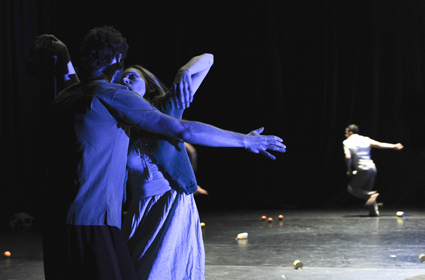
Sam Chester’s Safety in Numbers
photo Heidrun Löhr
Sam Chester’s Safety in Numbers
Dance has long been popular in Sydney’s west. Once upon a time there was even a tertiary dance course producing professional choreographers and dancers. The demise of dance studies at University of Western Sydney was a significant loss but dance culture in the west has continued to develop in no small part due to Western Sydney Dance Action (WSDA), a resident organisation at Riverside Parramatta. Formed in 2001 its aim was to foster artists, community networks and develop audiences for dance in the area.
By 2011, the year Annette McLernon took over as director, Western Sydney Dance Action had grown from a grassroots organisation to a significant presenter of dance in Sydney. Director and board decided to reflect the growth of the organisation by rebranding it as FORM Dance Projects Inc. McLernon brings to FORM experience in a range of areas: as a filmmaker (documentaries and dance films); curator (film program, Perth International Arts Festival); and program manager for Bundanon Trust during its re-invigoration under CEO Deborah Ely.
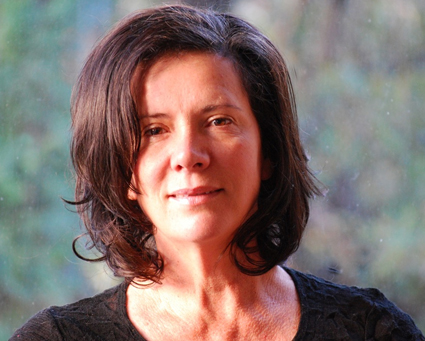
Annette McLernon
Showing
The Dance Bites program began with Western Sydney Dance Action and has continued to grow in strength presenting work by both established and emerging artists. McLernon says of FORM’s role, “[We] provide opportunities for independent contemporary dance artists in a landscape that’s really constricted. We function as an important part of the dance ecology. We are the ones providing the opportunities that are becoming so limited, particularly in the last few years.”
The 2013 program perfectly illustrated FORM’s ethos of diversity. It included established choreographer Martin del Amo’s Little Black Dress Suite (see RT117); The Tap Pack, by Jesse Rasmussen, Jordan Pollard and Thomas J Egan; Lineage, a group of dancers involved in mainstream musicals who funded their work via commercial means; and a double bill by Aruna Gandhimathinathan, Shruti Ghosh and Tammi Gissell exploring traditional and contemporary Indian and Australian Aboriginal dance forms. The latter artists came through FORM’s strong connection with the Cultural Performing Arts Network (CPAN) which has now reached a membership of 500. McLernon says, “I think it’s really important to present works that come from Western Sydney and are created in Western Sydney.”
The 2014 Dance Bites program, while not so wildy varied in terms of genre, shows a commitment to supporting dance practitioners at different stages of their careers. Established Perth choreographer Sue Peacock kicked off the season with her work Reflect, toured by Performing Lines WA (See RT115). Coming up shortly is Sam Chester’s Safety in Numbers, a work about how humans behave in the aftermath of disaster. Chester has developed the work through the Culminate program (Force Majeure with Performance Space and Carriageworks). McLernon says, “Sam is in a great position now in her career to have this opportunity and FORM is really happy that we can facilitate that.”
As part of the 2013 program, FORM also presented the first work by a group of 10 emerging artists, the Dance Makers Collective. Two of these pieces have been further developed and will be shown as a double bill in the 2014 program: Sketch by Flatline—choreographer Carl Sciberras, visual artist Todd Fuller and composer Mitchell Mollison—a multimedia exploration of the interplay between movement, music and vision; and Between Two and Zero by Miranda Wheen (see Miranda Wheen’s In Profile) and Matt Cornell “imagining a social dance for the future” (website). The final work for the program is by Bodyweather artist Linda Luke. Still Point Turning is a performance/installation investigating “deep time” including “cosmic time, the eternal cycle of living and dying” (website).
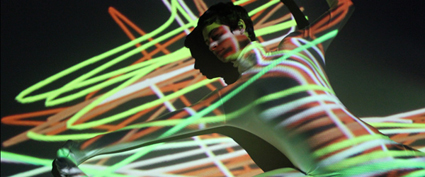
Flatline, Sketch
photo Carl Sciberras
Flatline, Sketch
Sharing
At the core of FORM Dance Project’s agenda is education for both young dancers and audiences. McLernon describes it as “aspirational,” involving a choreographic workshop for Year 12 dance students in partnership with the Sydney Dance Company, and also the Learn the Repertoire, See the Show sessions for students years 7-12. McLernon explains, “That’s really to give the opportunity [to] these young dancers to not just participate in the skills workshop but to see the work, get a better understanding of it and talk to the artists about what it’s like to be a dancer—what the career pathways are.” McLernon stresses that these exchanges also include artform appreciation. “Whether they go on to become dancers or not, that artform appreciation and understanding of dance—what contemporary dance is and can become—is really important for developing those future audiences for dance.”
Futures
McLernon has big plans for the future. In the last year FORM has launched a new website which has seen close to a million views last year. McLernon says, “commissioning Vicki Van Hout (http://form.org.au/blog) as FORM’s blogger in residence in 2013 and 2014 has contributed to growing FORM’s on-line audience and making a contribution to reputable critical discourse around contemporary dance.” She wants the site to become even more active with more video and rich media content.
In addition to this online hub, McLernon hopes FORM will become a dance centre. “At the moment we provide some support to create new works but we really would like to become a physical hub where we can give opportunities to early career artists, for instance, Dance Makers Collective—they have the potential to develop into a company. FORM would also like to offer more funding support for those types of artists to set up their own companies.” Plans are also in development for a membership system with McLernon envisaging the hub as a place where members “can come in and have a sense of community and develop work, with studios hopefully.” If Annette McLernon can make this happen, it will be a truly welcome addition to the cultural landscape not just of Western Sydney but the city and the state as a whole.
FORM Dance Projects, Dance Bites: Safety in Numbers, Sam Chester, 9-12 April; Double Bill: Sketch, Flatline; Between Two and Zero, Matt Cornell & Miranda Wheen; 11-13 Sept; Still Turning Point, Linda Luke 27-29 Nov; Lennox Theatre Riverside; http://form.org.au/; http://form.org.au/perform/dance-bites/
RealTime issue #119 Feb-March 2014 pg. web
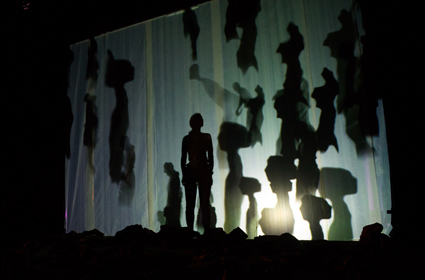
Deborah Leiser-Moore, KaBooM
photo Lachlan Woods
Deborah Leiser-Moore, KaBooM
I recently met with a very happy Deborah Leiser-Moore to discuss her busy career (which includes performing in a new work by Richard Schechner in New York this year), her latest creation, KaBooM, to premiere in April in Melbourne, and the Lee Breuer Masterclass (Breuer, a co-founder of Mabou Mines, creates large-scale innovative works in New York) she has programmed with Monash University Academy of Performing Arts for July. We’ve continued our discussion by email and phone and I’ve drawn on material on the artist’s website.
The Suzuki Tadashi-trained Leiser-Moore spent her formative years as performer and maker in Sydney’s contemporary performance scene, maturing with significant works: Hungry in 1996 and a room with no air in 1999. She then moved to Melbourne where she formed Tashmadada (running workshops with the likes of La Fura dels Baus), producing new works and touring overseas.
Leiser-Moore describes her new work KaBooM as “a promenade performance in which the audience encounter the different worlds and stories of seven men.” Each of these has been a soldier, each in a different country and with very different experiences.
The soldiers portrayed include one who deserted Saddam Hussein’s army after serving for a decade, a child soldier from Burundi and a 16 year-old Holocaust escapee who fought “for his family in the Pacific Islands along with a guardian monkey.”
How did you find and select, meet and interview the men you chose as your subjects, and over what period?
Over a period of around 10 months. A couple of the men I already knew. Majid, from Iraq, I had even worked with. Others I sourced by asking around my different networks. Fablice from Burundi I found through Multicultural Arts Victoria. It’s amazing how many men living in Australia carry around this war experience.
Once I found them, we met to get a sense of their stories and to outline the project and the process. I only had one rejection! They all were very happy to have an opportunity to tell their stories. They all said that the process of being interviewed allowed them to speak personally and freely. It gave them an opportunity to speak in ways they normally don’t feel they can. And they all were intrigued as to how I was going to make a performance piece—not verbatim theatre—from the material.
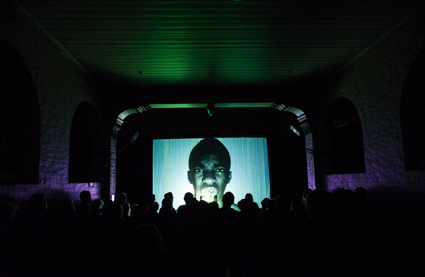
Deborah Leiser-Moore, KaBooM
photo Lachlan Woods
Deborah Leiser-Moore, KaBooM
How did you distill what you heard and learned from them?
I was interested in the personal stories of the men—not the politics of each of the wars they fought in. It was the question of how we live, as ordinary human beings, in extraordinary situations, how we are able to do day to day things we take for granted, what particular experiences the men remembered and what they carried of these to Australia.
The strong lineup of directors for KaBooM comprises Australians Regina Heilmann, Gail Kelly, Adriano Cortese and Susie Dee, Younes Bachir from Barcelona, Lech Mackiewicz from Poland and Bagryana Popov, who works in Bulgaria and Australia. What attributes have you looked for in the directors you’ve chosen?
I wanted to work with directors who are performance makers and who have their own very distinctive approaches. I’ve already had working relationships with Regina Heilmann and Younes Bachir and I knew the work of the others.
Each uses multiple performance languages in really interesting and visceral ways, so I felt they would respond to the interviews in lateral ways. I wanted directors who would create, in collaboration with me, responses to the interviews rather than verbatim pieces, because I’m interested in how these stories can reach an audience through the senses.
Also, I wanted each of the ‘stories’ to have a very specific and individual aesthetic, to make a point about the individuality of each of the men and their experiences. I think it is too easy to cluster people together as ‘Other.’ These are very different people from different countries with different stories and experiences. Therefore each of the pieces in the work is a different ‘world’— like an installation/performance piece. The audience is asked to enter each of these worlds.
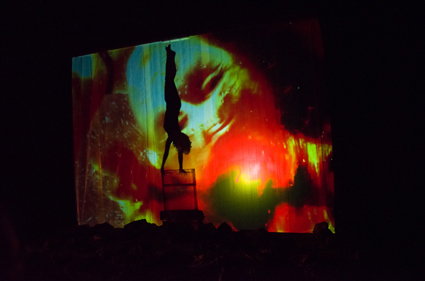
Deborah Leiser-Moore, KaBooM
photo Lachlan Woods
Deborah Leiser-Moore, KaBooM
In the press release for KaBooM, Leiser-Moore asks, “What happens when we are unwillingly thrust into the frontline of war? It can happen to anyone, anywhere. Our lives irrevocably and unpredictably changed in an instant. And what remains within us when we have escaped the warzone?” Her response takes the form of a physically realised account of soldiers’ lives that “positions the audience, as witness, in the midst of the performance arena. They are placed in a metaphorical field of war, populated with visual imagery and the debris of battle” (website). Within this arena Leiser-Moore will deploy her movement skills—including aerial work—projections, a soundtrack by Bigtoxic “and elements—mud, water, tomatoes, hay—to create a series of interlocking performance vignettes.”
Why the choice of particular materials for each piece?
Each director was given the filmed interview and asked to create a 10-minute response in their own performance ‘style.’ The process of performance making and the use of materials emerged out of discussions, each director’s particular aesthetic and their direct response to the interviews. Most of the directors are visual and physical performance makers, as am I. Together we used whatever material and form seemed right for the piece.
How do you feel about your body becoming a conduit for the experiences of others? What does your body, its skills and training offer these stories without words?
I think it’s important to communicate these very male war experiences through the body of a woman. It completes the ‘picture.’ My body and its own history—training and personal—can allow an audience to read the stories.
The experiences of war touch everyone—including those who are left behind—generally women: the mother whose son doesn’t return, the wife whose husband is only a ghostly memory. All lives are damaged by war. Sadly this is its universality. And so although I am the conduit for the experiences of others, this experience touches us all. In a way, this is the aim of this work.
* * * * * *
: 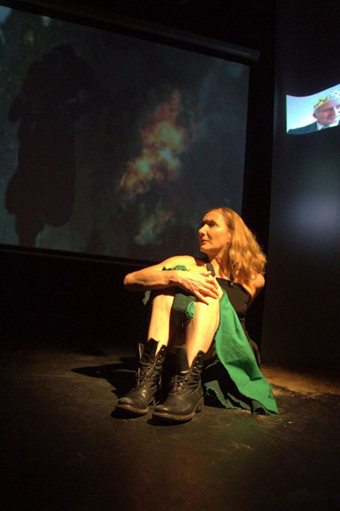
Deborah Leiser-Moore, Cordelia, Mein Kind
photo Ryszard Pajda
Deborah Leiser-Moore, Cordelia, Mein Kind
Other works
Leiser-Moore’s Cordelia, Mein Kind (2009) will enjoy a return season in Melbourne this year at La Mama. The artist describes the solo work as “a duet for live body and film.” Leiser-Moore as Cordelia encounters Lear in exile in the form of her father—a Holocaust victim displaced to Australia who appears on film in the performance (made before his death) conversing with his daughter. Performed in Melbourne, Brisbane, Washington, Gdansk and San Francisco, the work was created in collaboration with director Meredith Rogers and choreographer Sally Smith when Leiser-Moore was an artist-in-residence at Victoria University in Melbourne.
Of the work, the later Doug Leonard wrote in RealTime, “This deeply textured, multilayered and savagely poetical work takes off from Shakespeare’s King Lear, but unravels personal elements of cultural exile and loss. Leiser-Moore’s Yiddish speaking Polish father escaped to Australia from the Holocaust, but left his family behind. However, he never spoke a word to his daughter about his past until she arranged a trip with him back to Poland, which she documents. His favourite film was a Yiddish version of King Lear with a happy ending! The piece abounded with such astounding ironies and coincidences from real life, I was literally rendered speechless” (RT94).
Further Leiser-Moore productions include Here and There—Then and Now (2004) “a video/installation/performance piece that explores the inherent nature and expression of ritual (the wedding ceremony), tradition and culture within Jewish and Muslim women; a room with no air (1999), a collaboration with co-performer Regina Heilmann and composer Elena Kats-Chernin, in which a German gentile and Polish Jew “struggle to understand and unhinge the terrible dynamic which is their legacy;” and Hungry (1996), an exploration of the artist’s cultural heritage and the exclusion of women from Jewish religious ritual. In development with Heilmann is Apres Savage, a creative assessment of what has changed in the world and in the artists themselves since that first collaboration.
Deborah Leiser-Moore, KaBooM: Stories from Distant Frontlines fortyfivedownstairs, Melbourne, April 10-13; http://www.deborahleisermoore.com/kaboom.html
RealTime issue #119 Feb-March 2014 pg.
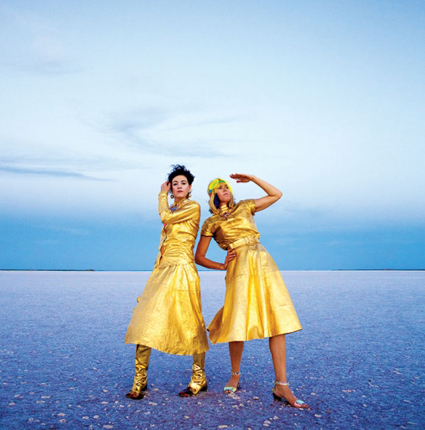
Chicks on Speed, UTOPIA
Since the late 90s art-music-political-punk ensemble Chicks on Speed—Alex Murray-Leslie (US) and Melissa Logan (Aus)—have produced an extensive catalogue of records, performances, exhibitions, fashion, film projects and, most recently, iPad apps. Now in their 17th year the uncompromising duo continues to engineer exciting multidisciplinary work including a new interactive album, UTOPIA, and a major exhibition at Fremantle Arts Centre, Perth.
Forming in Munich in 1997 after meeting at an Academy of Fine Arts party, Murray-Leslie and Logan began Chicks on Speed as part of a location-specific survival strategy. Murray-Leslie describes 90s Munich as being a bourgeois town with little in the way of creative entertainment to satisfy the pair. In this climate she set up an illegal bar that doubled as a venue for Chicks on Speed to create and present “radical entertainment” in the form of live art performances.
One such performance titled I Wanna Be A DJ…Baby! involved smashing records from behind a DJ desk while playing sound collage through the PA. Beyond onstage antics they also distributed a ‘box set’ featuring a T-shirt, cassette, paper record and fake ‘band’ interview.’ Murray-Leslie says, “It was never just the idea of the song but always the idea of the mixtape, the song, performing the song, making the merchandise, doing some text over the performance and then breaking something. Always the influence of Fluxus there—instructional performance.”
Beyond Fluxus, the concept of Gesamtkunstwerk, a German word translated as ‘the all encompassing artwork’ involving construction across many mediums, connects closely to the aesthetic of Chicks on Speed. Gesamtkunstwerk originated in the opera world, predominantly via Richard Wagner in the late 19th century but was adopted by Bauhaus architects in the early 20th century and is still relevant to many multi-disciplinary artists today. “We’ve never been able to just think in one medium,” says Murray-Leslie, “whether it’s art, fashion or music they all have a complementary trajectory.”
Chicks on Speed Band and Chicks on Speed Art Collective have always co-existed comfortably but with so many creative disciplines demanding attention, Murray-Leslie and Logan deliberately shift focus, navigating their way between the music world to the art world and back again. “In the beginning Chicks on Speed were never recognised as a real band,” Murray-Leslie explains. “When we became a functioning band people never saw our art. We changed the focus. Suddenly we go to release the new album, UTOPIA, and it’s swung back the other way.”
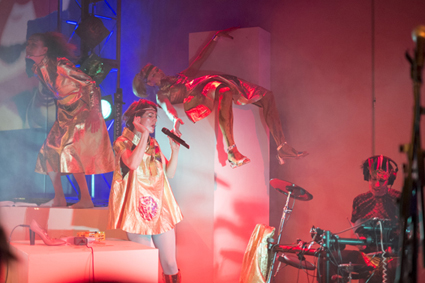
Chicks on Speed
UTOPIA is the product of years of sonic experimentation stretching beyond the conventional three-stage process of writing, recording and releasing to include new technologies, collaborations and audience participation. It comes complete with six iPad apps designed to be played and modified in co-authorship and co-creation with the band. During live shows apps are used as audio-visual instruments for interactive stage performance, for example allowing an audience member to contribute text to be displayed on a projected backdrop located behind the band. According to Murray-Leslie, during this process “the audience completes the artwork.” Despite the addition of iPad apps, UTOPIA remains sonically in keeping with the Chicks on Speed sound—energetic electro-pop songs with prominent lyrical content linking complex ideas about art, culture, idealism and creation to the broader concept of Utopia.
The apps are part of a much bigger body of creative work undertaken by Chicks on Speed which blurs the line between music, art, technology and laboratory. Objektinstruments (self-made instruments) were initially developed by the ensemble in 2005 for studio and stage implementation and showcased as part of a performative installation at Dundee Contemporary Arts Centre (UK) in 2010. During 2011 and 2013, as artist residents at ZKM Centre for Art and Media (Germany), they produced UTOPIA along with the six interconnected iPad apps. Collaborations from a diverse range of modern thinkers and creators such as Julian Assange, Yoko Ono and Francesca Thyssen provided extra dimensions to the music project.
For Melissa Logan new interactive technologies such as iPad apps enable Chicks on Speed “to remain close to the audience and to build up platforms.” In the early 2000s she felt distanced from fans due to the emergence of iTunes and other online retailers. She says that it was as if a conversation was lost because of third party involvement. The pair are conscious of maintaining a closeness with audiences. Alex Murray-Leslie notes, “Once you deliver something in the digital medium it is dead unless you change it.”
In 2014 Chicks on Speed show no signs of slowing down. The boundaries between art and music become blurrier as their catalogue of work encompasses even more creative disciplines.
Chicks on Speed, SCREAM, Fremantle Arts Centre (Perth), 4 April-25 May
http://fac.org.au/events/429/chicks-on-speed-scream?pid=58
Chicks on Speed, UTOPIA is available soon: http://www.chicksonspeed.com, https://soundcloud.com/chicks-on-speed
RealTime issue #119 Feb-March 2014 pg. web


